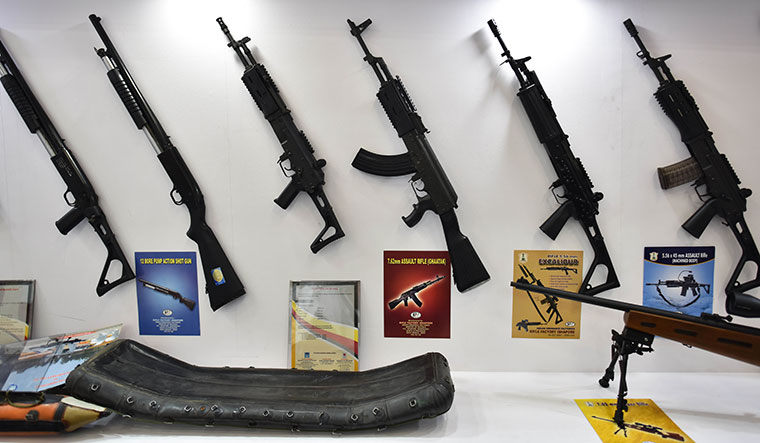SUBHASH CHANDRA’S first day in office as secretary, defence production—August 24—began on a good note: the defence ministry convinced the employee unions of the Ordnance Factory Board (OFB) to suspend their month-long strike, launched on August 20.
More than 82,000 employees from 41 ordnance factories across the country were protesting against the government’s move to corporatise the OFB, fearing the eventual privatisation of the factories. In a first, all three unions—the left-affiliated All India Defence Employees Federation (AIDEF), the Congress-affiliated Indian National Defence Workers Federation and the RSS-affiliated Bharatiya Pratiraksha Mazdoor Sangh—joined hands in protest.
Though Chandra, in an hour-long meeting, assured the unions that no final decision had been taken about the OFB’s corporatisation and that all their concerns would be addressed by a high-level committee, there is little the defence ministry can do. For, the move to corporatise the OFB figures in the 167 ‘transformative ideas’ to be implemented in the first 100 days of Modi 2.0. The OFB, once corporatised, would become a defence public sector undertaking (DPSU); currently, it is an attached office of the department of defence production. In a statement, the defence ministry said: “Corporatisation will bring the OFB on par with other DPSUs. This is in its interest as it will provide operational freedom and flexibility, which it presently lacks.”
OFB employees, however, said that ordnance factories have been kept as a departmental organisation for more than 200 years because of the special nature of the defence industry, like volatility, non-uniform demand from the armed and paramilitary forces and uneconomic quantities to be produced to meet strategic needs, which a corporation will not be able to manage. For instance, a ‘war reserve’ has to be maintained to take care of surge in demands in a war-like situation—this reserve had kicked in during the Kargil war. “In purely commercial terms, maintaining idle capacity would be detrimental to the business interest of the corporation or PSU. Therefore, ordnance factories should continue as a departmental organisation,” the AIDEF stated in its representation to Defence Minister Rajnath Singh.
The OFB’s history, which manufactures everything from tanks and artillery guns to uniforms, tents and boots for our security forces, dates back to 1775 when the Britishers officially recognised the Board of Ordnance in Fort William, Kolkata. The first factory came up in 1801—Gun Carriage Agency (now Gun & Shell Factory)—at Cossipore, Kolkata.
Defence ministry officials said that while ordnance factories were set up as “captive centres” to serve the needs of the armed forces, they have been facing performance issues, like low quality and productivity, delayed delivery and high costs. In the last two decades, three committees—T.K.A. Nair Committee (2000), Vijay Kelkar Committee on Defence Reforms (2005) and the Vice Admiral Raman Puri Committee (2015)—had suggested an overhaul of the OFB. Another committee headed by retired lieutenant general D.B. Shekatkar suggested regular performance audits of all ordnance units.
While the Nair committee suggested that the OFB be converted into the Ordnance Factory Corporation Limited, the Kelkar committee recommended that it be given the Navratna status à la the Bharat Sanchar Nigam Ltd. The Kelkar committee observed that in the existing setup, ordnance factories do not have access to newer technologies. Also, they have no say in selection of raw materials, supplies and quality control. Sustaining them in the current structure would prove costly and, in the long run, mar the country’s defence preparedness.
The Puri committee recommended splitting the current OFB into three or four segments and converting these into DPSUs. It suggested a fixed tenure of three years for the chairman and board members. Recently, two chairmen served only for six months each, said ministry officials. “It hampers continuity in the working of the OFB and also impedes bold decision-making,” said an official.
In 2016, additional controller general of defence accounts A.K. Saxena, in his report, said that the OFB was overcharging clients. Also, the Army, its biggest customer, has reportedly had accidents owing to defective ammunition provided by the OFB. A ministry official put the figure at 20 fatal and 129 non-fatal accidents in the past ten years.
In a move to end the OFB’s monopoly, last year the government notified 275 non-core items that the armed forces could buy from the open market. Ministry officials claim that the OFB has all along supplied products to armed forces on nomination basis, leaving little room for the OFB to improve the product quality or to devise a customer feedback and redressal system. There have been several complaints about the OFB missing its deadlines. As per available figures till July 31, the OFB has met only less than half of its production and supply target.
OFB chairman Saurabh Kumar, in a statement, said that the government’s move would enable ordnance factories to respond faster to future needs of the armed forces and boost the export potential of its products. The OFB unions, however, said that Kumar’s statement did not factor in their opinion.
“Any private manufacturer only looks at the profit. National interest will be his last [priority]. Quality assurance in the private sector will be done by third party inspection and self-certification. It puts the lives of our jawans and armed forces at risk,” said M.K. Ravindran Pillai, vice president, AIDEF. “One cannot give production of core items like missiles to a private player.”
A senior official with defence production, however, said that the autonomy the ordnance factories will have once they are corporatised would bring areas like research and development, quality control and financial accounting directly under their management. “Further, they will be free to take policy decisions for market expansion and technological upgrade,” he said, “enabling them to play the role of lead designer, integrator and key market player in the defence sector.”


